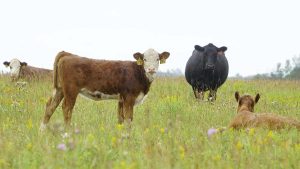By Leeann Minogue
The Livestock & Forage Centre of Excellence
Are cattle getting the best possible diets? Are there better ways to test herds for disease? How does manure affect the atmosphere and soil? At Saskatchewan’s Livestock & Forage Centre of Excellence, experts have access to all the animals, pastures, feedlots and state-of-the-art technology they need to find answers to questions about everything related to beef production.

Since its official opening in 2018, the LFCE has been a place where academics, government and industry can come together to collaborate on research that will guide the future of beef production. The Centre is equipped with all the tools and resources researchers need, and it’s well-connected to ranchers and industry, which keeps research focused on real-world problems.
Everything experts need to study the beef industry can be found under one “roof” at the LFCE, though in the case of the 400-head cowherd on pasture southeast of Saskatoon, that roof is the sky. At the Goodale Farm, researchers can monitor pasture health and how animals graze. At the 1,500-head feedlot at nearby Clavet, researchers can investigate feedlot management practices. When they need inside information, experts can access the Centre’s state-of-the-art metabolism barn. This facility is fully equipped to measure all of the food cattle consume, as well as everything that comes out the other end. The Centre even has two bison herds, giving researchers a chance to study bison breeding and disease.

Collaborating for the future
This wide variety of resources brings all kinds of experts together. Veterinarians, plant breeders, beef nutritionists, soil scientists, graduate students and other researchers can collaborate in areas where they have common interests, working together to answer questions about beef production. Professors at the College of Agriculture and Bioresources can bring their students to the LFCE for labs and workshops, so ag grads will have the hands-on knowledge they need to succeed.
“The research we do offers potential improvements and solutions to all aspects of the beef cattle industry, from the soil right through to the finished animal,” says Bruce Coulman, interim director of the LFCE. “That’s of great importance to the beef industry. Most of the work we do is looking for practices that are economically and environmentally sustainable.”
Current research at the Centre runs the gamut from environmental impacts of feedlots to how grazing is influenced by an animal’s temperament. Another study is finding optimal ways of testing animals in feedlots to minimize the need for antibiotics. Experts are looking at feed additives that could reduce cattle’s methane production. Access to the LFCE’s animal herds and specialized facilities gives academics and graduate students a place to put their theories to the test in real-world conditions.

Finding Answers to the Right Questions
The LFCE’s connection to actual cattle producers gives researchers a unique window into the industry and provides a way to deliver research to ranchers. It’s not easy to get research results from professors to the pasture, but the LFCE is set up to make this exchange work.
Tamara Carter, a rancher from Lacadena, Saskatchewan, is a member of the Centre’s Strategic Advisory Committee. Tamara is excited about the Centre’s capacity to research forages, the plants that cattle eat. Cattle spend 80% of their lives grazing grasslands, then eat preserved hay in winter. As well as nourishing cattle, forages absorb their manure, sequestering carbon.

Rain is not always a sure thing for Saskatchewan ranchers, and forages are one of the most expensive inputs on Tamara’s ranch. Ranchers want to find ways to keep their pastures healthy and productive so their ranches remain profitable and sustainable well into the future. “Researchers aren’t always connected to producers,” Tamara says. “The Centre gives them a way to connect, so research can be tailored to what’s needed most out on the ranch.”
“Consumers are interested in where their food comes from, and I think they’re interested in learning more about how beef is produced,” says Bruce Coulman.
University researchers want to know they’re working on relevant problems. Governments want to fund projects that will lead to positive change. It takes a facility as broad as the LFCE to bring all these parties together to build the future of the beef industry.
“As a producer,” says Tamara Carter, “I want to find out, ‘Are there ways to do this better?’”
With its wide-angled look at the livestock industry, the LFCE will find ways for all of the players in the beef industry to do things better and continue to produce Canadian beef sustainably.



 Ranchers & Brewers Make Two Products From One
Ranchers & Brewers Make Two Products From One